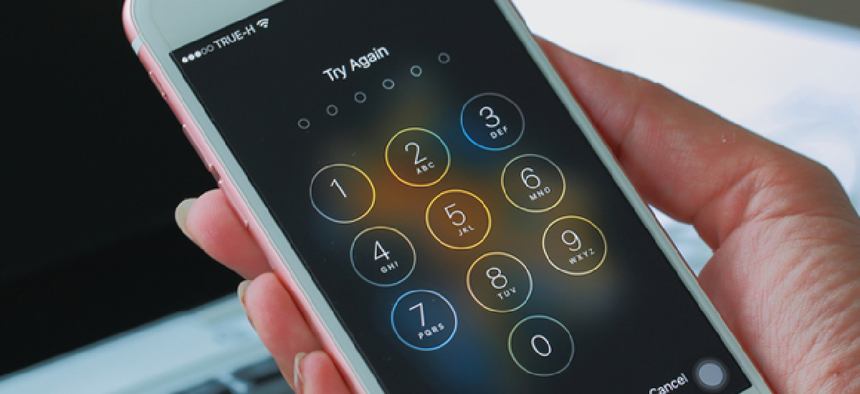Another mass shooting, another locked phone


Connecting state and local government leaders
Federal investigators want access to the Texas shooter's locked phone, but most security researcher think it’s a bad idea.
When Susan Landau decided to write “Listening In: Cybersecurity in an Insecure Age,” it was at a time when encryption was on many people’s minds.
After a shooter in San Bernardino, Calif., killed 14 people, investigators were unable to get into his iPhone. They pressured Apple to let them into the device before getting a third-party company to defeat the phone's security measures. The debate over whether law enforcement should have a "back door" into a citizen’s phone was suddenly a national issue with then-FBI Director James Comey on one side and private industry on the other.
Now there is another locked phone that investigators believe might provide insight into the Texas shooting that left 26 people dead.
That phone was flown to Quantico, and FBI agents were in the process of examining it.
“Unfortunately, at this time, we are unable to get into that phone,” FBI Special Agent Christopher Combs said in a press conference. “So it actually highlights an issue that you’ve all heard about before: with the advance of the technology in the phones and the encryptions, law enforcement, whether it’s at the state, local or federal level, is increasingly not able to get into these phones.”
Reuters was able to confirm the phone was an iPhone, and that the FBI didn’t seek Apple’s assistance during an important 48-hour period. A statement from Apple said the company reached out to the FBI after learning the bureau was trying to unlock the phone when Combs made his statements in a press conference, according to Buzzfeed.
On Nov. 9, Deputy Attorney General Rod Rosenstein said the federal government has a right to access the phone, according to The Hill, reaffirming the stance Attorney General Jeff Sessions was taking even before the shooting in Texas.
Some observers don't understand why the FBI wants to access the phone. Most of a phone's contents can be accessed in other ways, Nate Cardozo, a senior staff attorney for the Electronic Frontier Foundation, told GCN.
“Quite frankly, I have no idea what they would expect to find in a phone that they wouldn’t find elsewhere,” Cardozo said.
He suggested investigators go to Apple for the contents of iCloud backups and a list of every app on the phone. The mobile service provider can provide a list of who was called and texted from the device. App makers might not be able to uncover the contents in the shooter's applications, but they can still show the contacts of messaging apps. “Almost everything” can be accessed another way, he said.
Riana Pfefferkorn, a cryptography fellow at the Stanford Center for Internet and Society, said the phone could contain information not available elsewhere, like data stored and deleted locally, but in this case she doesn’t see the point.
“I don’t think this is a case where that would be forensically significant,” Pfefferkorn said of accessing the phone.
An FBI spokesperson declined to comment for this story.
A bill introduced in the last session of Congress by Sens. Richard Burr (R-N.C.) and Dianne Feinstein (D-Calif.) would have mandated a back door. Pfefferkorn wrote in the Just Security blog at the time that the bill is costly, doesn’t prevent criminals from hiding activity and would allow vulnerabilities to be introduced.
“A back door is an intentional vulnerability being introduced into a system,” she told GCN. “It acts as a point of access that otherwise would not exist, and in doing so it makes the system more vulnerable … a back door isn’t just used by good guys, it can also be used by bad guys.”
Another legislative path to accessing phone data would be getting rid of the exemptions within of Communications Assistance for Law Enforcement Act, which required that telecom providers provide a way for law enforcement to tap into phone conversations, but it doesn’t cover internet and encryption, Pfefferkorn said.
The smartphone has become vital for two-factor authentication, Landau pointed at the New America event. With the creation of a back door, the phone would become useless for this task, she said.
Even Michael Hayden, who once ran the National Security Administration and was tasked with breaking encryption as part of his job, said he sides with tech companies like Apple on this issue
"on security grounds, not privacy grounds and not commercial grounds,” he said, after the San Bernardino attack.
But there are experts out there who think it’s “technically feasible” to create “lawful, privacy-preserving surveillance.”
Joan Feigenbaum from the computer science department at Yale University and Bryan Ford of the Swiss Federal Institute of Technology recently published a paper that makes this argument.
“In general,” they wrote, “there has been great progress in recent years on implementation and application of privacy-preserving computational techniques, including secure, multiparty computation, homomorphic encryption, and private information retrieval.”
They describe their solution as one that makes “essential use of computation on encrypted data; roughly speaking, they enable agencies to obtain a large set of encrypted data about both targeted and untargeted users, feed it into a cryptographic protocol that winnows it down to the records of users targeted by a John Doe warrant, and decrypt only those records.”
The National Academies is also looking into the options and tradeoffs of giving law enforcement access to the plain text of encrypted information. The academy is still working on the study, but it defines the purpose as finding “ways to measure or otherwise characterize risks so that they could be weighed against the potential law enforcement or intelligence benefits.”
NEXT STORY: Blockchain: Getting government beyond the hype




